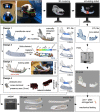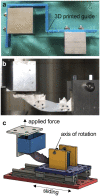3D printed plates based on generative design biomechanically outperform manual digital fitting and conventional systems printed in photopolymers in bridging mandibular bone defects of critical size in dogs
- PMID: 37065217
- PMCID: PMC10098091
- DOI: 10.3389/fvets.2023.1165689
3D printed plates based on generative design biomechanically outperform manual digital fitting and conventional systems printed in photopolymers in bridging mandibular bone defects of critical size in dogs
Abstract
Conventional plate osteosynthesis of critical-sized bone defects in canine mandibles can fail to restore former functionality and stability due to adaption limits. Three-dimensional (3D) printed patient-specific implants are becoming increasingly popular as these can be customized to avoid critical structures, achieve perfect alignment to individual bone contours, and may provide better stability. Using a 3D surface model for the mandible, four plate designs were created and evaluated for their properties to stabilize a defined 30 mm critical-size bone defect. Design-1 was manually designed, and further shape optimized using Autodesk ® Fusion 360 (ADF360) and finite element analysis (FE) to generate Design-2. Design-4 was created with the generative design (GD) function from ADF360 using preplaced screw terminals and loading conditions as boundaries. A 12-hole reconstruction titanium locking plate (LP) (2.4/3.0 mm) was also tested, which was scanned, converted to a STL file and 3D printed (Design-3). Each design was 3D printed from a photopolymer resin (VPW) and a photopolymer resin in combination with a thermoplastic elastomer (VPWT) and loaded in cantilever bending using a customized servo-hydraulic mechanical testing system; n = 5 repetitions each. No material defects pre- or post-failure testing were found in the printed mandibles and screws. Plate fractures were most often observed in similar locations, depending on the design. Design-4 has 2.8-3.6 times ultimate strength compared to other plates, even though only 40% more volume was used. Maximum load capacities did not differ significantly from those of the other three designs. All plate types, except D3, were 35% stronger when made of VPW, compared to VPWT. VPWT D3 plates were only 6% stronger. Generative design is faster and easier to handle than optimizing manually designed plates using FE to create customized implants with maximum load-bearing capacity and minimum material requirements. Although guidelines for selecting appropriate outcomes and subsequent refinements to the optimized design are still needed, this may represent a straightforward approach to implementing additive manufacturing in individualized surgical care. The aim of this work is to analyze different design techniques, which can later be used for the development of implants made of biocompatible materials.
Keywords: additive manufacturing; autodesk fusion 360; biomechanical evaluation; canine; critical size; customized endoprosthesis; jaw; osteosynthesis.
Copyright © 2023 Baumgartner, Schramel, Kau, Unger, Oberoi, Peham and Eberspächer-Schweda.
Conflict of interest statement
The authors declare that the research was conducted in the absence of any commercial or financial relationships that could be construed as a potential conflict of interest.
Figures





Similar articles
-
Biomechanical behavior of the three-dimensionally printed surgical plates for mandibular defect reconstruction: a finite element analysis.Comput Assist Surg (Abingdon). 2023 Dec;28(1):2286181. doi: 10.1080/24699322.2023.2286181. Epub 2023 Nov 27. Comput Assist Surg (Abingdon). 2023. PMID: 38010807
-
A customized fixation plate with novel structure designed by topological optimization for mandibular angle fracture based on finite element analysis.Biomed Eng Online. 2017 Nov 15;16(1):131. doi: 10.1186/s12938-017-0422-z. Biomed Eng Online. 2017. PMID: 29141673 Free PMC article.
-
Biomechanical feasibility of non-locking system in patient-specific mandibular reconstruction using fibular free flaps.J Mech Behav Biomed Mater. 2023 Dec;148:106197. doi: 10.1016/j.jmbbm.2023.106197. Epub 2023 Oct 18. J Mech Behav Biomed Mater. 2023. PMID: 37875041
-
Biomechanical and biological aspects of defect treatment in fractures using helical plates.Acta Chir Orthop Traumatol Cech. 2014;81(4):267-71. Acta Chir Orthop Traumatol Cech. 2014. PMID: 25137496 Review.
-
The Use of Titanium 3D Mini-Plates in the Surgical Treatment of Fractures of the Mandibular Condyle: A Systematic Review and Meta-Analysis of Clinical Trials.J Clin Med. 2021 Aug 16;10(16):3604. doi: 10.3390/jcm10163604. J Clin Med. 2021. PMID: 34441900 Free PMC article. Review.
Cited by
-
Significance and considerations of establishing standardized critical values for critical size defects in animal models of bone tissue regeneration.Heliyon. 2024 Jun 29;10(13):e33768. doi: 10.1016/j.heliyon.2024.e33768. eCollection 2024 Jul 15. Heliyon. 2024. PMID: 39071581 Free PMC article. Review.
References
LinkOut - more resources
Full Text Sources

